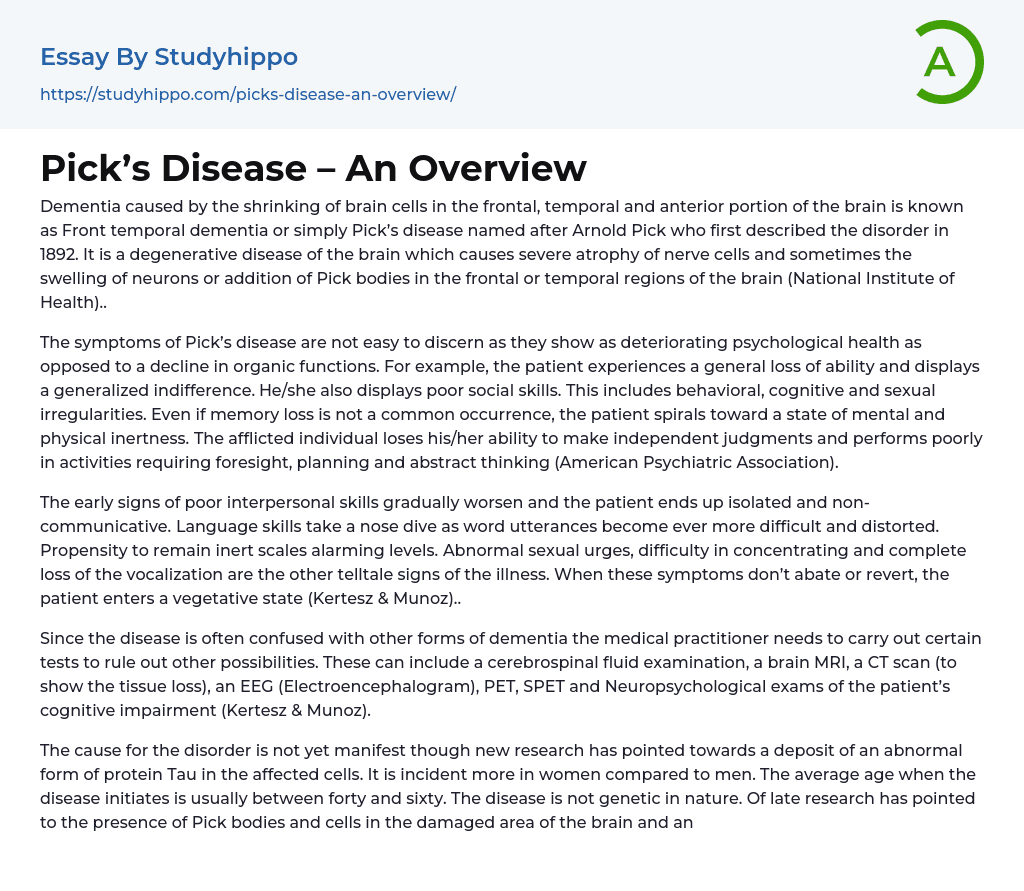Front temporal dementia, also known as Pick's disease, is a type of dementia caused by the shrinking of brain cells in the frontal, temporal, and anterior regions of the brain. Arnold Pick first discovered this condition in 1892. It is characterized by the gradual breakdown of nerve cells, potential inflammation of neurons, and the formation of Pick bodies within the frontal or temporal areas of the brain (National Institute of Health).
The symptoms of Pick’s disease are difficult to detect as they manifest as a deterioration in psychological health rather than a decline in organic functions. This includes a overall loss of ability and a general indifference. The patient also exhibits limited social skills, encompassing behavioral, cognitive, and sexual irregularities. While memory loss may not be frequent, the patient progressively becomes mentally and physically inactive. The affected person loses their capacity to make independent judgments and per
...forms poorly in activities requiring foresight, planning, and abstract thinking (American Psychiatric Association).
The initial signs of inadequate interpersonal skills progressively deteriorate, leading to the individual becoming isolated and non-communicative. Language abilities decline significantly, resulting in more challenging and distorted speech. The inclination to remain inactive reaches alarming levels. Other indicative symptoms of the illness include abnormal sexual desires, difficulty focusing, and complete loss of vocalization. If these indications do not improve or reverse, the patient eventually enters a vegetative state (Kertesz ; Munoz).
Medical professionals often perform various tests to rule out other possible causes and determine if a patient has a particular illness, as it is frequently mistaken for different forms of dementia. These tests may include examining cerebrospinal fluid, conducting an MRI scan of the brain, using a CT
scan to detect tissue loss, performing an EEG or PET scan, utilizing SPET scans, and conducting neuropsychological assessments to assess cognitive decline (Kertesz & Munoz).
Recent research suggests that the etiology of this disorder remains unidentified, although there is a hypothesis that an atypical type of protein Tau might amass in the impacted cells. It is more prevalent among females than males and usually initiates between forty and sixty years old. Genetic factors are not deemed influential in its onset. Moreover, investigations have detected Pick bodies and cells, along with an anomalous variant of protein Tau, within the affected brain area (American Psychiatric Association).
According to emedicinehealth.com, there is no specific treatment for Picks Disease. However, constant care and monitoring are crucial for the affected person. Medications should be administered to alleviate symptoms like confusion, decline in cognitive functions, and aggressive or self-destructive behavior. It is recommended to avoid psychotherapy due to the potential risk of disorientation.
It is important to continuously monitor the patient as their disease progresses, and it is necessary to involve family members or a healthcare provider. Encouraging supervised social activities and participation in self-help groups can be beneficial. Lifestyle changes should be made to accommodate limitations and reduce confusion. To prevent accidental harm, hazardous substances, medications, equipment, and gadgets should be removed from the patient's surroundings. Emotional support from a caregiver is essential for the patient's daily life along with appropriate medication as it aids in regaining orientation (National Institute of Health).
Internet sources:
Books:
The 1994 edition of the Diagnostic and Statistical Manual of Mental Disorders, known as DSM-IV-TR, was published by American Psychiatric Publications Inc., and developed
by the American Psychiatric Association.
Andrew Kertesz and David G. Munoz collaborated as editors on a book entitled "Pick's Disease and Pick Complex," which was published in March 1998 by Wiley-Liss. The book is identified by the ISBN 047117792X.
Frontotemporal dementia, also referred to as Pick's disease, is distinguished by the reduction in size of brain cells in the frontal, temporal, and anterior regions of the brain. This progressive condition was initially identified by Arnold Pick in 1892. It causes substantial decay of nerve cells and may also lead to neurons swelling or the development of Pick bodies within the frontal or temporal areas of the brain (National Institute of Health).
The symptoms of Pick’s disease present as a decline in psychological health rather than the decline of organic functions. This includes general loss of ability and indifference, as well as poor social skills. These symptoms manifest in behavioral, cognitive, and sexual irregularities. While memory loss may not be common, the patient gradually becomes mentally and physically inert. The affected individual experiences a loss.
- Pregnancy essays
- Death essays
- Asthma essays
- Chronic Pain essays
- Diabetes essays
- Infection essays
- Infertility essays
- Pain essays
- Sexually Transmitted Disease essays
- Cholesterol essays
- Epidemic essays
- Pathogen essays
- Symptom essays
- Water supply essays
- Myocardial Infarction essays
- Chronic essays
- Hypertension essays
- Black Death essays
- Breast Cancer essays
- Down Syndrome essays
- Apoptosis essays
- Tuskegee Syphilis Experiment essays
- Type 2 Diabetes essays
- Cloning essays
- Medical Ethics essays
- Patient essays
- Therapy essays
- drugs essays
- Cannabis essays
- Aspirin essays
- Cardiology essays
- Hemoglobin essays
- Pharmacology essays
- Surgery essays
- alternative medicine essays
- Plastic Surgery essays
- Organ Donation essays
- Vaccines essays
- Medical essays
- Dentist essays
- Psychological Trauma essays
- Physical therapy essays
- Cold essays
- Cocaine essays
- Why Marijuana Should Be Legalized essays
- Drug Abuse essays
- Teenage Drug Abuse essays
- Heart Disease essays
- Artery essays
- Insanity essays




